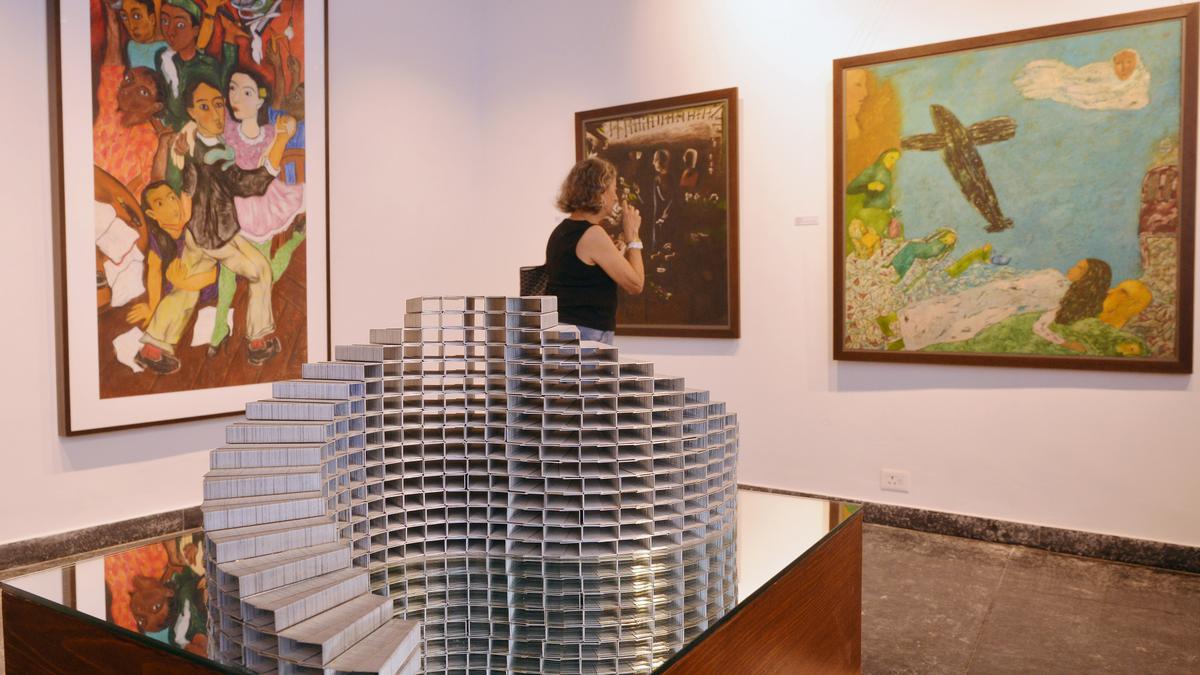
Check out Kiran Nadar Museum of Art’s first exhibition in Chennai
The Hindu
Titled The Moving Arc, the retrospective traverses the diverse schools of art while charting the creative journey of modern and radical artists of the post-colonial India
On a rainy afternoon, the visitors at the gallery of Chennai’s Lalit Kala Akademi espy a post-colonial India in all its glory: condensed in canvases, frozen in bronze and captured on a digital screen. They see art that embodies a young, curious India thrilled by its newly tasted cultural emancipation.
Look to the right to find NN Rimzon’s The Tools, a 1993 sculpture that was born out of the Indian Radical Painters’ and Sculptors’ Association that was heavily inspired by Marxist ideologies. Look to the left to find a wall that effortlessly carries the weight of SH Raza’s canvases: a colourful Bahori Kadal (Kashmir) and the crowded Kashmir Valley of 1949 are among them. Or perhaps MF Husain’s painted wood works — Kisan, for instance — that almost seem in motion from the 1950s. Further, KCS Paniker’s famed Mother and Child in hues of earthy pink, greens and blues takes us closer to home. And an entire wall dedicated to Cholamandal Artists Village’s dearest K Ramanujam is a poignant reminder of the rich legacy of Madras Art Movement.
The narratives are multiple, parallel and layered, which means setting a chronology is near to impossible. Kiran Nadar Museum of Art’s first show in Chennai — an easy show-stopper of the ongoing Madras Art Weekend — traces the crisscrossing of artistic schools and perspectives that originated in thepost-colonial, modernist India. With a display comprising 180 artworks by 38 artists, The Moving Arc boasts of canvases by both, masters and young radicals of the ever-growing Modernist movement.
“I have always felt that Chennai has a great attitude of positivity towards art. Here, there is much more spontaneity when compared to a city like Delhi,” says Kiran Nadar, philanthropist and founder of Kiran Nadar Museum of Art. Her personal collection of art that spans over 150 years built over a period forms the cornerstone of the museum that opened in 2010. She started by collecting the Progressives: Souza, Raza, Husain…while building a new home.
“Four or five years later, it got to a point that I didn’t even get to see the works because they were in storage. The idea of setting up a museum came from there,” says Nadar.
Steering the conversation towards the works on display, Nadar says, “For this particular curation, we were not able to bring a lot of large sculptural works. For me, what is very amazing about it is that I had forgotten that some of these canvases exist with us.”
The post-colonial response, as mapped out in the display, though gradual, has happened across regions and time. “In this exhibit, we wanted to stress on these crisscrosses because all of these artists have migrated at different points in their practice. These crisscrosses have led to a substantive cross-fertilisation of ideas and visual languages,” says Rubeena Kharoga, curator of The Moving Arc.











